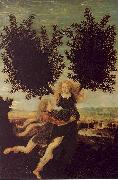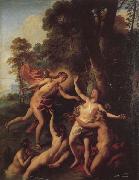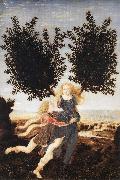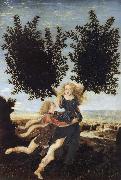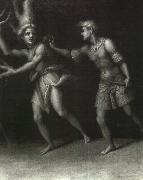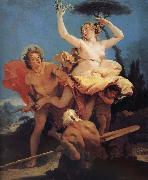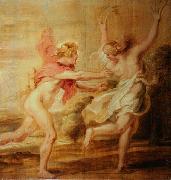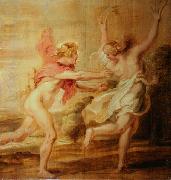Wholesale Oil Painting No Minimum |
|||||||||||
|
|
|||||||||||

|
|||||||||||
|
|
|
||||||||
Antonio Pollaiuolo1431-1498 Italian Antonio Pollaiuolo Galleries Sculptor, painter, designer and engraver. He was trained as a goldsmith and bronze sculptor, probably in Lorenzo Ghiberti workshop. In 1466 he joined the Arte della Seta, the silkworkers guild (to which goldsmiths traditionally belonged), and he listed himself as a goldsmith and painter in the membership records of the Compagnia di S Luca in 1473; this is the only documented reference to him as a painter. In his tax return in 1480 he reported that he was renting a workshop specifically for goldsmiths work. He still described himself as a goldsmith, and not as a painter, in his last tax return in 1496. |
||||||||
|
|
||||||||
Apollo and Daphne
Apollo and Daphne Painting ID:: 1588 |
c1470 National Gallery, London c1470 National Gallery, London |
|||||||
|
|
||||||||
Jean-Francois De TroyFrench 1679-1752 Jean-Francois De Troy Gallery Jean François de Troy was born on January 27, 1679 in Paris. The successful career of Jean François de Troy was based initially on large historical and allegorical compositions, such as Time Unveiling Truth (1733) in the National Gallery, London, but he is now most highly regarded for his smaller and more spirited scenes of elegant social life. They are among the best of those that rode on the wave of Watteau's success??indeed The Alarm, or the Gouvernante Fid??le (Victoria and Albert Museum, London, 1723) was attributed to Watteau in the 19th century. A versatile artist, he made tableaux de modes famous, painting histories and mythologies in a colourful and fluent manner which owed something to both Veronese and Peter Paul Rubens. He undertook commissions for Versailles and Fontainebleau between 1724 and 1737, and designed two sets of tapestries for the Gobelins, each of seven subjects, the Histoire d'Esther (1737-40) and the Histoire de Jason (1743-6). In 1738 he was appointed Director of the French Academy in Rome, and spent the rest of his life there. De Troy's wife died prematurely, and he lost of all his seven children. Jean François de Troy died on January 26, 1752 in Rome. |
||||||||
|
|
||||||||
|
|
Apollo and Daphne
Apollo and Daphne Painting ID:: 29055 |
mk65
Oil on canvas
80x53"
mk65 Oil on canvas 80x53" |
||||||
|
|
||||||||
Antonio Pollaiuolo1431-1498 Italian Antonio Pollaiuolo Galleries Sculptor, painter, designer and engraver. He was trained as a goldsmith and bronze sculptor, probably in Lorenzo Ghiberti workshop. In 1466 he joined the Arte della Seta, the silkworkers guild (to which goldsmiths traditionally belonged), and he listed himself as a goldsmith and painter in the membership records of the Compagnia di S Luca in 1473; this is the only documented reference to him as a painter. In his tax return in 1480 he reported that he was renting a workshop specifically for goldsmiths work. He still described himself as a goldsmith, and not as a painter, in his last tax return in 1496. |
||||||||
|
|
||||||||
|
|
Apollo and Daphne
Apollo and Daphne Painting ID:: 31370 |
nn07
c1470 National Gallery, London nn07 c1470 National Gallery, London |
||||||
|
|
||||||||
Antonio Pollaiuolo1431-1498 Italian Antonio Pollaiuolo Galleries Sculptor, painter, designer and engraver. He was trained as a goldsmith and bronze sculptor, probably in Lorenzo Ghiberti workshop. In 1466 he joined the Arte della Seta, the silkworkers guild (to which goldsmiths traditionally belonged), and he listed himself as a goldsmith and painter in the membership records of the Compagnia di S Luca in 1473; this is the only documented reference to him as a painter. In his tax return in 1480 he reported that he was renting a workshop specifically for goldsmiths work. He still described himself as a goldsmith, and not as a painter, in his last tax return in 1496. |
||||||||
|
|
||||||||
|
|
Apollo and Daphne
Apollo and Daphne Painting ID:: 42880 |
mk170
1475-1480
Oil on wood
29.5x20cm
mk170 1475-1480 Oil on wood 29.5x20cm |
||||||
|
|
||||||||
PontormoItalian Mannerist Painter, 1494-ca.1556 Italian painter and draughtsman. He was the leading painter in mid-16th-century Florence and one of the most original and extraordinary of Mannerist artists. His eccentric personality, solitary and slow working habits and capricious attitude towards his patrons are described by Vasari; his own diary, which covers the years 1554-6, further reveals a character with neurotic and secretive aspects. Pontormo enjoyed the protection of the Medici family throughout his career but, unlike Agnolo Bronzino and Giorgio Vasari, did not become court painter. His subjective portrait style did not lend itself to the state portrait. He produced few mythological works and after 1540 devoted himself almost exclusively to religious subjects. His drawings, mainly figure studies in red and black chalk, are among the highest expressions of the great Florentine tradition of draughtsmanship; close to 400 survive, forming arguably the most important body of drawings by a Mannerist painter. |
||||||||
|
|
||||||||
|
|
Apollo and Daphne
Apollo and Daphne Painting ID:: 62062 |
mk276 1513 Oil Painting 60 x 47.3cm years Wolfsburg Booker Levi Cornell University mk276 1513 Oil Painting 60 x 47.3cm years Wolfsburg Booker Levi Cornell University |
||||||
|
|
||||||||
Giovanni Battista TiepoloItalian Rococo Era Painter, 1696-1770 Giovanni Battista Tiepolo was born in Venice on March 5, 1696. His father, who was part owner of a ship, died when Tiepolo was scarcely a year old, but the family was left in comfortable circumstances. As a youth, he was apprenticed to Gregorio Lazzarini, a mediocre but fashionable painter known for his elaborately theatrical, rather grandiose compositions. Tiepolo soon evolved a more spirited style of his own. By the time he was 20, he had exhibited his work independently, and won plaudits, at an exhibition held at the church of S. Rocco. The next year he became a member of the Fraglia, or painters guild. In 1719 he married Cecilia Guardi, whose brother Francesco was to become famous as a painter of the Venetian scene. They had nine children, among them Giovanni Domenico and Lorenzo Baldassare, who were also painters. In the 1720s Tiepolo carried out many large-scale commissions on the northern Italian mainland. Of these the most important is the cycle of Old Testament scenes done for the patriarch of Aquileia, Daniele Dolfin, in the new Archbishop Palace at Udine. Here Tiepolo abandoned the dark hues that had characterized his early style and turned instead to the bright, sparkling colors that were to make him famous. |
||||||||
|
|
||||||||
|
|
Apollo and Daphne
Apollo and Daphne Painting ID:: 62177 |
mk280 Oil on canvas 96 x 79cm mk280 Oil on canvas 96 x 79cm |
||||||
|
|
||||||||
Dosso Dossi1479-1542 Italian Dosso Dossi Locations Italian painter of the Ferrarese school, whose real name was Giovanni di Niccolo de Luteri. He may have been a pupil of Lorenzo Costa, but was certainly influenced by Giorgione, Titian, and Raphael. He often collaborated with his brother Battista, a landscape painter. Dosso Dossi is first recorded in Mantua, but after 1514 he executed many decorative works for the ducal palace and churches of Ferrara, including frescoes, pictures, and cartoons for tapestries. Both his landscapes and portraits show originality and imagination. He was a friend of Ariosto, who mentions him in Orlando Furioso. His works include Circe in the Woods (Borghese Villa); The Three Ages of Man (Metropolitan Mus.); The Standard Bearer, Scene from a Legend, and Saint Lucretia (National Gall. of Art, Washington, D.C.). |
||||||||
|
|
||||||||
|
|
Apollo and Daphne
Apollo and Daphne Painting ID:: 70287 |
Medium Oil on canvas
Dimensions 01,194 X 118 cm
Medium Oil on canvas Dimensions 01,194 X 118 cm |
||||||
|
|
||||||||
Peter Paul RubensFlemish Baroque Era Painter, 1577-1640 Peter Paul Rubens (June 28, 1577 ?C May 30, 1640) was a prolific seventeenth-century Flemish Baroque painter, and a proponent of an exuberant Baroque style that emphasized movement, color, and sensuality. He is well-known for his Counter-Reformation altarpieces, portraits, landscapes, and history paintings of mythological and allegorical subjects. In addition to running a large studio in Antwerp which produced paintings popular with nobility and art collectors throughout Europe, Rubens was a classically-educated humanist scholar, art collector, and diplomat who was knighted by both Philip IV, king of Spain, and Charles I, king of England. Rubens was a prolific artist. His commissioned works were mostly religious subjects, "history" paintings, which included mythological subjects, and hunt scenes. He painted portraits, especially of friends, and self-portraits, and in later life painted several landscapes. Rubens designed tapestries and prints, as well as his own house. He also oversaw the ephemeral decorations of the Joyous Entry into Antwerp by the Cardinal-Infante Ferdinand in 1635. His drawings are mostly extremely forceful but not detailed; he also made great use of oil sketches as preparatory studies. He was one of the last major artists to make consistent use of wooden panels as a support medium, even for very large works, but he used canvas as well, especially when the work needed to be sent a long distance. For altarpieces he sometimes painted on slate to reduce reflection problems. His fondness of painting full-figured women gave rise to the terms 'Rubensian' or 'Rubenesque' for plus-sized women. The term 'Rubensiaans' is also commonly used in Dutch to denote such women. |
||||||||
|
|
||||||||
|
|
Apollo and Daphne
Apollo and Daphne Painting ID:: 82101 |
Date ca. 1636(1636)
Medium Oil on wood
Dimensions 28.5 x 27.5 cm (11.2 x 10.8 in)
cjr Date ca. 1636(1636) Medium Oil on wood Dimensions 28.5 x 27.5 cm (11.2 x 10.8 in) cjr |
||||||
|
|
||||||||
Francesco Albani(March 17 or August 17, 1578 COctober 4, 1660) was an Italian Baroque painter. Born at Bologna, his father was a silk merchant who intended to instruct his son in the same trade; but by age twelve, Albani became an apprentice under the competent mannerist painter Denis Calvaert, where he met Guido Reni. Soon he followed Reni to the so-called "Academy" run by the Carracci family: Annibale, Agostino, and Ludovico. This studio fostered the careers of many painters of the Bolognese school, including Domenichino, Massari, Viola, Lanfranco, Giovanni Francesco Grimaldi, Pietro Faccini, Remigio Cantagallina, and Reni. In the year 1600, Albani moved to Rome to work in the fresco decoration of the gallery of the Palazzo Farnese, being completed by the studio of Annibale Carracci. Rome, under Clement VIII Aldobrandini (1592-1605) was exhibiting some degree of administrative stability and renewed artistic patronage. While pope Clement was born from a Florentine family residing in Urbino, his family was allied by marriage to the Emilia-Romagna and the Farnese, since Ranuccio I Farnese, Duke of Parma had married Margherita Aldobrandini. Parma, like Bologna, are part of the Region of Emilia-Romagna. Thus it was not surprise that Cardinal Odoarde Farnese, Ranuccio's brother, chose the Carraccis from Bologna for patronage, thereby establishing Bolognese predominance of Roman fresco painting for nearly two decades. |
||||||||
|
|
||||||||
|
|
Apollo and Daphne
Apollo and Daphne Painting ID:: 82414 |
ca. 1615-1620 (1600-1625)
Medium Oil on copper of panel
Dimensions 17.5 x 35.5 cm (6.9 x 14 in)
cyf ca. 1615-1620 (1600-1625) Medium Oil on copper of panel Dimensions 17.5 x 35.5 cm (6.9 x 14 in) cyf |
||||||
|
|
||||||||
Peter Paul RubensFlemish Baroque Era Painter, 1577-1640 Peter Paul Rubens (June 28, 1577 ?C May 30, 1640) was a prolific seventeenth-century Flemish Baroque painter, and a proponent of an exuberant Baroque style that emphasized movement, color, and sensuality. He is well-known for his Counter-Reformation altarpieces, portraits, landscapes, and history paintings of mythological and allegorical subjects. In addition to running a large studio in Antwerp which produced paintings popular with nobility and art collectors throughout Europe, Rubens was a classically-educated humanist scholar, art collector, and diplomat who was knighted by both Philip IV, king of Spain, and Charles I, king of England. Rubens was a prolific artist. His commissioned works were mostly religious subjects, "history" paintings, which included mythological subjects, and hunt scenes. He painted portraits, especially of friends, and self-portraits, and in later life painted several landscapes. Rubens designed tapestries and prints, as well as his own house. He also oversaw the ephemeral decorations of the Joyous Entry into Antwerp by the Cardinal-Infante Ferdinand in 1635. His drawings are mostly extremely forceful but not detailed; he also made great use of oil sketches as preparatory studies. He was one of the last major artists to make consistent use of wooden panels as a support medium, even for very large works, but he used canvas as well, especially when the work needed to be sent a long distance. For altarpieces he sometimes painted on slate to reduce reflection problems. His fondness of painting full-figured women gave rise to the terms 'Rubensian' or 'Rubenesque' for plus-sized women. The term 'Rubensiaans' is also commonly used in Dutch to denote such women. |
||||||||
|
|
||||||||
|
|
Apollo and Daphne
Apollo and Daphne Painting ID:: 85709 |
1636(1636)
Medium Oil on wood
Dimensions 28.5 x 27.5 cm (11.2 x 10.8 in)
cyf 1636(1636) Medium Oil on wood Dimensions 28.5 x 27.5 cm (11.2 x 10.8 in) cyf |
||||||
|
|
||||||||
Carl Christian Klasspainted Apollo and Daphne in |
||||||||
|
|
||||||||
|
|
Apollo and Daphne
Apollo and Daphne Painting ID:: 90326 |
oil on canvas, 199 x 141 cm
1775
cjr oil on canvas, 199 x 141 cm 1775 cjr |
||||||
|
|
||||||||
|
Carl Christian Klass painted Apollo and Daphne in Apollo and Daphne oil on canvas, 199 x 141 cm 1775 cjr |
||||||||
|
|
||||||||
|
Prev Next
|
||||||||
|
|
||||||||
|
Related Paintings to Carl Christian Klass :. |
||||||||
|
|
||||||||
|
CONTACT US |
